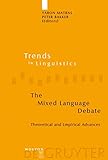The Mixed Language Debate : Theoretical and Empirical Advances / ed. by Yaron Matras, Peter Bakker.
Material type: TextSeries: Trends in Linguistics. Studies and Monographs [TiLSM] ; 145Publisher: Berlin ; Boston : De Gruyter Mouton, [2008]Copyright date: ©2003Description: 1 online resource (325 p.)Content type:
TextSeries: Trends in Linguistics. Studies and Monographs [TiLSM] ; 145Publisher: Berlin ; Boston : De Gruyter Mouton, [2008]Copyright date: ©2003Description: 1 online resource (325 p.)Content type: - 9783110177763
- 9783110197242
- 400
- online - DeGruyter
- Issued also in print.
| Item type | Current library | Call number | URL | Status | Notes | Barcode | |
|---|---|---|---|---|---|---|---|
 eBook
eBook
|
Biblioteca "Angelicum" Pont. Univ. S.Tommaso d'Aquino Nuvola online | online - DeGruyter (Browse shelf(Opens below)) | Online access | Not for loan (Accesso limitato) | Accesso per gli utenti autorizzati / Access for authorized users | (dgr)9783110197242 |
Frontmatter -- Contents -- The study of mixed languages -- Social factors and linguistic processes in the -- emergence of stable mixed languages -- Mixed languages and acts of identity: An -- evolutionary approach -- What lies beneath: Split (mixed) languages as -- contact phenomena -- Mixed languages as autonomous systems -- Mixed languages: Re-examining the structural -- prototype -- Language contact and group identity: The role of -- "folk" linguistic engineering -- The linguistic properties of lexical manipulation -- and its relevance for Ma’á -- Can a mixed language be conventionalized -- alternational codeswitching? -- Not quite the right mixture: Chamorro and Malti as -- candidates for the status of mixed language -- Backmatter
restricted access online access with authorization star
http://purl.org/coar/access_right/c_16ec
Mixed Languages are speech varieties that arise in bilingual settings, often as markers of ethnic separateness. They combine structures inherited from different parent languages, often resulting in odd and unique splits that present a challenge to theories of contact-induced change as well as genetic classification. This collection of articles is devoted to the theoretical and empirical controversies that surround the study of Mixed Languages. Issues include definitions and prototypes, similarities and differences to other contact languages such as pidgins and creoles, the role of codeswitching in the emergence of Mixed Languages, the role of deliberate and conscious mixing, the question of the existence of a Mixed Language continuum, and the position of Mixed Languages in general models of language change and contact-induced change in particular. An introductory chapter surveys the current study of Mixed Languages. Contributors include leading historical linguists, contact linguists and typologists, among them Carol Myers-Scotton, Sarah Grey Thomason,William Croft, Thomas Stolz, Maarten Mous, Ad Backus, Evgeniy Golovko, Peter Bakker, Yaron Matras.
Issued also in print.
Mode of access: Internet via World Wide Web.
In English.
Description based on online resource; title from PDF title page (publisher's Web site, viewed 28. Feb 2023)


